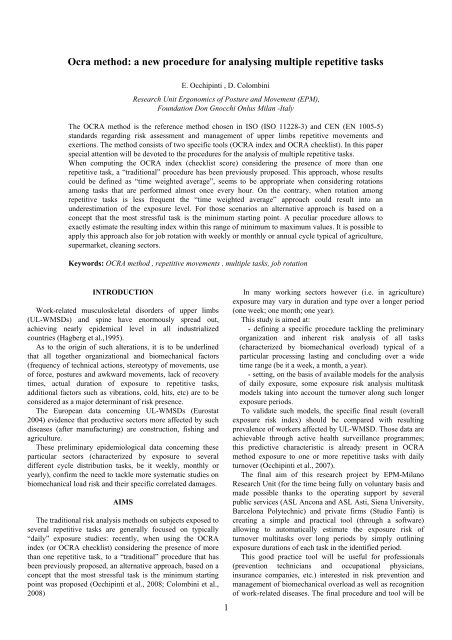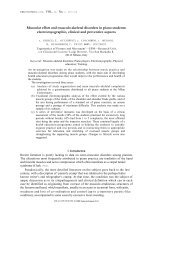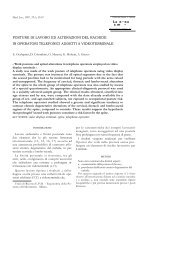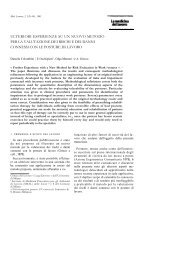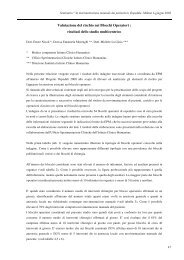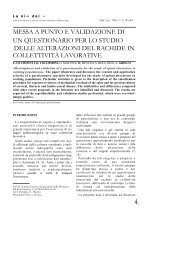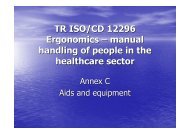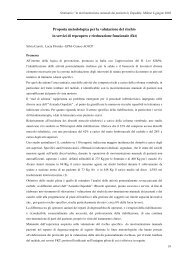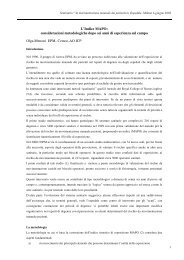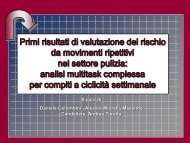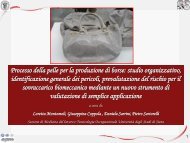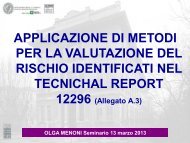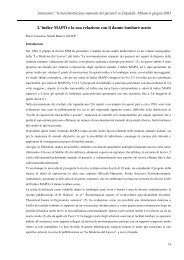Ocra method a new procedure for analysing multiple repetitive tasks
Ocra method: a new procedure for analysing multiple ... - epm
Ocra method: a new procedure for analysing multiple ... - epm
You also want an ePaper? Increase the reach of your titles
YUMPU automatically turns print PDFs into web optimized ePapers that Google loves.
<strong>Ocra</strong> <strong>method</strong>: a <strong>new</strong> <strong>procedure</strong> <strong>for</strong> <strong>analysing</strong> <strong>multiple</strong> <strong>repetitive</strong> <strong>tasks</strong>E. Occhipinti , D. ColombiniResearch Unit Ergonomics of Posture and Movement (EPM),Foundation Don Gnocchi Onlus Milan -ItalyThe OCRA <strong>method</strong> is the reference <strong>method</strong> chosen in ISO (ISO 11228-3) and CEN (EN 1005-5)standards regarding risk assessment and management of upper limbs <strong>repetitive</strong> movements andexertions. The <strong>method</strong> consists of two specific tools (OCRA index and OCRA checklist). In this paperspecial attention will be devoted to the <strong>procedure</strong>s <strong>for</strong> the analysis of <strong>multiple</strong> <strong>repetitive</strong> <strong>tasks</strong>.When computing the OCRA index (checklist score) considering the presence of more than one<strong>repetitive</strong> task, a “traditional” <strong>procedure</strong> has been previously proposed. This approach, whose resultscould be defined as “time weighted average”, seems to be appropriate when considering rotationsamong <strong>tasks</strong> that are per<strong>for</strong>med almost once every hour. On the contrary, when rotation among<strong>repetitive</strong> <strong>tasks</strong> is less frequent the “time weighted average” approach could result into anunderestimation of the exposure level. For those scenarios an alternative approach is based on aconcept that the most stressful task is the minimum starting point. A peculiar <strong>procedure</strong> allows toexactly estimate the resulting index within this range of minimum to maximum values. It is possible toapply this approach also <strong>for</strong> job rotation with weekly or monthly or annual cycle typical of agriculture,supermarket, cleaning sectors.Keywords: OCRA <strong>method</strong> , <strong>repetitive</strong> movements , <strong>multiple</strong> <strong>tasks</strong>, job rotationINTRODUCTIONWork-related musculoskeletal disorders of upper limbs(UL-WMSDs) and spine have enormously spread out,achieving nearly epidemical level in all industrializedcountries (Hagberg et al.,1995).As to the origin of such alterations, it is to be underlinedthat all together organizational and biomechanical factors(frequency of technical actions, stereotypy of movements, useof <strong>for</strong>ce, postures and awkward movements, lack of recoverytimes, actual duration of exposure to <strong>repetitive</strong> <strong>tasks</strong>,additional factors such as vibrations, cold, hits, etc) are to beconsidered as a major determinant of risk presence.The European data concerning UL-WMSDs (Eurostat2004) evidence that productive sectors more affected by suchdiseases (after manufacturing) are construction, fishing andagriculture.These preliminary epidemiological data concerning theseparticular sectors (characterized by exposure to severaldifferent cycle distribution <strong>tasks</strong>, be it weekly, monthly oryearly), confirm the need to tackle more systematic studies onbiomechanical load risk and their specific correlated damages.AIMSThe traditional risk analysis <strong>method</strong>s on subjects exposed toseveral <strong>repetitive</strong> <strong>tasks</strong> are generally focused on typically“daily” exposure studies: recently, when using the OCRAindex (or OCRA checklist) considering the presence of morethan one <strong>repetitive</strong> task, to a “traditional” <strong>procedure</strong> that hasbeen previously proposed, an alternative approach, based on aconcept that the most stressful task is the minimum startingpoint was proposed (Occhipinti et al., 2008; Colombini et al.,2008)1In many working sectors however (i.e. in agriculture)exposure may vary in duration and type over a longer period(one week; one month; one year).This study is aimed at:- defining a specific <strong>procedure</strong> tackling the preliminaryorganization and inherent risk analysis of all <strong>tasks</strong>(characterized by biomechanical overload) typical of aparticular processing lasting and concluding over a widetime range (be it a week, a month, a year).- setting, on the basis of available models <strong>for</strong> the analysisof daily exposure, some exposure risk analysis multitaskmodels taking into account the turnover along such longerexposure periods.To validate such models, the specific final result (overallexposure risk index) should be compared with resultingprevalence of workers affected by UL-WMSD. Those data areachievable through active health surveillance programmes;this predictive characteristic is already present in OCRA<strong>method</strong> exposure to one or more <strong>repetitive</strong> <strong>tasks</strong> with dailyturnover (Occhipinti et al., 2007).The final aim of this research project by EPM-MilanoResearch Unit (<strong>for</strong> the time being fully on voluntary basis andmade possible thanks to the operating support by severalpublic services (ASL Ancona and ASL Asti, Siena University,Barcelona Polytechnic) and private firms (Studio Fanti) iscreating a simple and practical tool (through a software)allowing to automatically estimate the exposure risk ofturnover multi<strong>tasks</strong> over long periods by simply outliningexposure durations of each task in the identified period.This good practice tool will be useful <strong>for</strong> professionals(prevention technicians and occupational physicians,insurance companies, etc.) interested in risk prevention andmanagement of biomechanical overload as well as recognitionof work-related diseases. The final <strong>procedure</strong> and tool will be
proposed <strong>for</strong> a <strong>new</strong> ISO TR “Application document <strong>for</strong> ISO11228- part 1,2 and 3 and <strong>for</strong> ISO 11226”METHODS: ORGANIZATIONAL DATAGeneral aspects <strong>for</strong> assessment of exposure levels to workscharacterized by multi-task turnoverWhen dealing with an exposure risk assessment (from upperlimb biomechanical overload) to multitask works, it isnecessary to go through 3 operating stages:- facing a preliminary organizational study to establish thekind of turnover: the periodicity of the different <strong>tasks</strong>(implemented by the worker or by the homogeneous group ofworkers employed in the same <strong>tasks</strong> in the considered period)repeated in time, daily or weekly or monthly or yearly.- defining the risk level inherent in each task, using theOCRA checklist. Intrinsic level means ascribing to the task anet duration of 440 minutes/shift with 2 breaks, 8-10 minuteseach, and a lunch break of at least 30 minutes.- applying specific mathematical models assessing exposureto “multi<strong>tasks</strong>”.As to calculation <strong>procedure</strong>s, the 3 stages will be tackled:first the daily, secondly yearly cycle multi<strong>tasks</strong> and later theweekly cycles.Cyclical turnover and organizational studies on exposureto daily rotating <strong>multiple</strong> <strong>tasks</strong>.This kind of turn-over is typical in the industry and easy toidentify: every day is similar to other.When the <strong>repetitive</strong> task turn-over is daily, 2 events mayoccur:- rotation occurs at least every hour:- rotation occurs less than once per hour.It is not so difficult to obtain accurate exposure data aboutthe net duration (in minutes) of each <strong>repetitive</strong> task in a shift.With these data the proportional distribution among <strong>tasks</strong>over the shift can be obtained being derived <strong>for</strong> each task as a% on the total of hours worked in the shift.The obtained percentages outline the intrinsic timedistribution present among developed <strong>tasks</strong>. The <strong>method</strong>sreported in previous papers (Occhipinti et al., 2008; Colombiniet al., 2008), and summarized (<strong>for</strong> the OCRA checklist) later,could be applied.Cyclical turnover and organizational studies on exposureto yearly rotating <strong>multiple</strong> <strong>tasks</strong>.While in the industry turnover periodicity is typically daily,in other productive sectors this periodicity is longer: <strong>for</strong>example in agriculture it is typically yearly. Each month of theyear is characterized by different processing, each includingdifferent <strong>tasks</strong>. Priority objective to this organizational studystage is identification of workers’ homogeneous groupcarrying out the same <strong>tasks</strong> over the year: which and howmany workers are involved and which <strong>tasks</strong> they carry out.Two solutions are proposed <strong>for</strong> studying the exposureduration to developed <strong>tasks</strong>: (a) a semi-qualitative option,which is simpler, when only few in<strong>for</strong>mation are available(e.g. from worker(s)’ interviews) and (b) the quantitativeoption based on knowledge of hours actually worked in themonth per each task.(a) Simplified organizational study (SEMI-QUALITATIVEMODEL)Table 1 shows a preliminary example of simpleidentification of the different <strong>tasks</strong> carried out by the sameworkers’ group (homogeneous group by job) over one year.It preliminarily reports:- the name of the different <strong>tasks</strong> carried-out in the year (A,B, C,…)- the number of days actually worked in the month- the task(s) carried out in that month (marked by 1)WORKING TASKSQUALITATIVE DESCRIPTION OF WORKED MONTHS / YEARJANFEBMARAPRMAYDAYS WORKED /MONTH 20 20 20 20 25 20 23 0 25 13 25 0 210,00A 1 1 1B 1 1 1C 1D 1E 1 1F 1 1G 1JUNELJULYAUGU2SEPTOCTNOVDECACTUALLY WORKED DAYS / YEARTable 1 - Example of simplified (semi-qualitative) description of the different <strong>tasks</strong> carried out by a homogenous group ofworkers over one year.These simple data already provide useful in<strong>for</strong>mationthrough calculation of percentage using exposure constants.These constants are: 20 days of work a month over 11 monthsa year.The first calibration <strong>procedure</strong>, through time constants, iscarried out to calculate in percentage the exposure days permonth:when the percentage exceeds 100, it means that the worker thatmonth has worked more than 20 days.This first percentage ascribes a semi-qualitative durationvalue to the <strong>tasks</strong> developed in the month and above markedby 1 (Table 1). In the example reported in Table 2, if in onemonth two <strong>tasks</strong> are carried out (see February with a 100%value: he/she has worked <strong>for</strong> 20 days), each task is ascribed
the half-month duration (0.5). If on the contrary in one month2 <strong>tasks</strong> are carried out (see July with a 113% value, i.e. he/sheworked over 20 days), each task is ascribed 0.6 proportionalduration (a little more than half a month).Then such numbers are summed up in horizontal, derivingthe number of “fictitious” months worked <strong>for</strong> each task in theyear. Such data will allow to derive the “assessed” percentagescorresponding to each task in the year (% of fictitious monthsworked as calibrated on the 11-month constant).(b) Quantitative organizational study (ANALYTICAL MODEL)Sometimes it is not so difficult to obtain more accurateexposure data (per month) such as detail of worked hours:actually these data are available in agricultural business beingthe basis <strong>for</strong> workers’ salary (Table 3).With these data the proportional distribution among <strong>tasks</strong>over the year can be easily obtained being derived <strong>for</strong> eachtask as a percentage on the total of hours worked in the year(Table 4).The obtained percentages outline the intrinsic timedistribution present among developed <strong>tasks</strong>.TASKS% OF DAYS / MONTHG WORKEDON CONSTANTQUALITATIVE DESCRIPTION OF WORKED MONTH / YEAR: percentage results weighted on 20 day/ month constantJANFEBMARAPRMAYJUNE100% 100% 100% 100% 125% 100% 113% 0% 125% 63% 125% 0%LJULYAUGUSEPTOCTNOVDECTOTAL INFICTITIOUSMONTHS% FICTITIOUSMONTHS WORKET ON11 MONTHSCONSTANTA 0,5 1,0 0,6 2,1 19,3%B 1,0 1,3 0,5 2,8 25,0%C 1,3 1,3 11,4%D 1,3 1,3 11,4%E 1,0 0,5 1,5 13,6%F 0,5 0,6 1,1 9,7%G 0 0,6 0,6 5,1%Table 2 - Processing of organizational data collected with simplified (semi-qualitative) description of the <strong>tasks</strong> carried outby a homogeneous group of workers over one year.TYPE OF WORKING TASKSDESCRIPTION OF WORKED HOURS / MONTH FOR EACH TASKJANFEBMARAPRMAYJUNELJULYAUGUSEPTOCTNOVDECTOTALHOURSA 80 160 100 340.00B 160 200 80 440.00C 200 200.00D 200 200.00E 160 80 240.00F 80 80 160.00G 100 100.00160 160 160 160 200 160 180 200 100 200 0 1680Table 3 - Example of duration of different <strong>tasks</strong> carried out by a homogenous group of workers over one year analyticallyexpressed in hours/month (analytical model)ESTIMATE OF PERCENTAGES STARTING FROM WORKED HOURS / MONTH FOR EACH TASKJANFEBMARAPRMAYA 50% 100% 100% 20,2%B 100% 100% 50% 26,2%C 100% 11,9%D 100% 11,9%E 100% 50% 14,3%F 50% 44% 9,5%G 56% 6,0%JUNELJULYAUGUSEPTOCTNOVDECProportional distribution of <strong>tasks</strong>100% 100% 100% 100% 100% 100% 100% 0% 100% 100% 100% 0% 100% (on 1680 hours)Table 4 - Example of different <strong>tasks</strong> carried out by a homogeneous group of workers over one year expressed in % on thetotal of hours worked in the year (intrinsic proportional distribution among the <strong>tasks</strong> developed in the year: worked outfrom Table 3).3
In addition, to describe the intrinsic time distribution of the<strong>tasks</strong> presented in Table 4, it is necessary to reassess theproportion by weighting them on “worked time constants”.Table 5 shows the generic reference working durationconstants expressed in hours/month (160), days/month (20),days/year (220), months work/year (11), worked hours/year(1760)Worked hours/ month constant 160 Working month constant 11Worked days/ month constant 20.0 Working hour/ year constant 1760Worked days/ year constant 220Table 5 - Duration constants of generic working activity tobe used to weight exposure duration.Starting (with reference to) from the constants reported inTable 5, we can calculate the weighted proportionaldistribution among the <strong>tasks</strong> developed in the year.The example reported in Table 6 sows this passage: the totaloriginal (from table 4) worked hours/year is 1680: consideringthat the constant used is equal to 1760 hours (table 5), there isa 0.5% reduction of working activity. The result is that thepercentages reported in the column of “weighted proportionaldistribution” (respect to the constant) are lower that those ofintrinsic proportional distribution. If by contrast, the total ofworked hours exceeds the constant, the % reported in thecolumn of calibrated proportional distribution will be higher.WORKING TASKSGENFEBMARAPRMAYJUNELJULYAUGUSEPTOCTNOVDECTOT.WORKEDHOURSINTRINSIC%1680 100,0% 95,5%A 50% 100% 100% 340 20,2% 19,3%B 100% 100% 50% 440 26,2% 25,0%C 100% 200 11,9% 11,4%D 100% 200 11,9% 11,4%E 100% 50% 240 14,3% 13,6%F 50% 44% 160 9,5% 9,1%G 56% 100% 100 6,0% 5,7%CONSTANTWEIGHTED%Table 6 - Example of calculation of weighted proportional distribution (considering the constant) among the <strong>tasks</strong> carriedout in the year and as compared with intrinsic proportional distribution (worked out from Table 3).THE OCRA METHOD FOR DAILY ROTATING TASKSOCRA checklist <strong>for</strong> assessment of “intrinsic level” ofexposureThe OCRA <strong>method</strong> (Occhipinti, 1998 ; Colombini et al.2002), now adopted by ISO (ISO 12228-3) and CEN(EN1005-5) standards suggests to identify and quantify thefollowing main risk factors which characterise a work-relatedexposure to <strong>repetitive</strong> <strong>tasks</strong>. They are: frequency of highaction, excessive use of <strong>for</strong>ce, awkward and/or stereotypedupper limb movements and postures, lack of appropriaterecovery periods, additional risk factors, net duration of the<strong>repetitive</strong> task(s).The OCRA <strong>method</strong> proposes two risk analysis tools: OCRAindex and OCRA checklist.OCRA checklistscoreUp to 7.57.6 – 11.011.1 – 14.014.1 – 22.5≥ 22.6OCRA indexscore2.22.3 – 3.53.6 – 4.54.6 – 9.0≥ 9.1Exposure levelsGREENYELLOWRED LIGHTRED MEDIUMRED HIGH= No risk= borderline= light risk= medium risk= high riskTable 7- The final score of OCRA checklist matched withOCRA index score and related risk ranges.After tackling the first organizational study stage(identification of developed <strong>tasks</strong> and turnover times, timeproportion in the final cyclic period, shift net duration andbreak distribution), the study aimed at obtaining final exposureOCRA checklist, is the priority analytical model bothduring the first risk assessment stage in a given workingsituation (mapping stage). Like OCRA index, the OCRAchecklist consists of 5 parts dedicated to the study of the fourmain risk factors (lack of recovery periods, frequency, <strong>for</strong>ce,awkward postures and stereotypy) and additional factors(vibrations, extreme cold temperatures, countershocks, etc.).The analytical scheme proposed by OCRA checklistidentifies pre-established numerical values (increasing versusrisk increase) <strong>for</strong> each of the 4 main risk factors and <strong>for</strong>additional factors.The sum of the obtained partial values produces a numericalfigure (score) allowing to assess the exposure level through arelationship with OCRA index values in a variety of ranges(green, yellow, red, purple), as described in Table 7.levels needs research of intrinsic OCRA checklist final valueof each identified task.When speaking of intrinsic value, we mean assessing eachtask as if it was the only task developed along the whole shift(approx 440 net minutes of <strong>repetitive</strong> task duration with alunch break of at least 30 minutes and two breaks of minimum8 minutes).Table 8 reports the examples of risk assessment withchecklist on a group of <strong>tasks</strong> developed in one year.Assessments are to be referred to one limb (in this case theright one) maintaining the score of each risk factor. The finalscore expresses the value of intrinsic index.
INTRINSIC checklistTYPE OF WORKING TASKSvalue (duraion 8 hoursincl. canteen and twobreaks 10 minutes each)A 4 7 2 RG 10 2 3 2 1.5 11.5 24.5B 4 7 2 RG 8 2 3 2 1.5 9.5 22.5C 4 7 1 RG 2 2 2 2 1.5 3.5 15.5D 4 9 0 RG 8 2 2 8 1.5 9.5 22.5E 4 8 3 RG 8 2 3 2 1.5 9.5 24.5F 4 5 0 RG 1 2 2 8 1.5 9.5 18.5G 4 5 2 RG 6 2 2 8 1.5 9.5 20.5recoveryfreq.<strong>for</strong>cesideshoulderTable 8 – examples of risk assessments with OCRA checklist on a group of processing developed in one year. Assessmentsare to be referred to the right limb. The score of each risk factor is reported. The final score expresses the value ofintrinsic index.wristelbowhandstereotypyTot postureadditionalThe OCRA checklist: summary of calculation models <strong>for</strong>daily rotation multitask exposure.When the <strong>repetitive</strong> task turnover is daily, 2 events mayoccur:a) rotation occurs at least every hour: in the <strong>for</strong>mer case,<strong>for</strong> exposure calculation, the time weighted average of finalintrinsic risk indices of each task is calculated using thefollowing <strong>for</strong>mula:Checklist OCRA Multitask Simple = [( pA x % tA) + (pBx % tB) +….+(i..pN x % tN)] x Md (1)Where:“pA”, “pB”, etc. are the checklist intrinsic scores of each task and %tA, %tB etc.represent the corresponding duration proportions (in %) in relation to the total durationof <strong>repetitive</strong> <strong>tasks</strong> developed in one shift (100% in all cases)Md = duration multiplier considering the total net duration of <strong>repetitive</strong> <strong>tasks</strong> in the shiftthat is the sum of each <strong>repetitive</strong> task duration (Table 9)60-120 min : Multiplying factor = 0.5121-180 min: Multiplying factor = 0,6581-240 min: Multiplying factor = 0.75241-300 min: Multiplying factor = 0,85301-360 min: Multiplying factor = 0,925361-420 min: Multiplying factor = 0,95421-480 min: Multiplying factor = 1> 480 min: Multiplying factor = 1,5Table 9 – Calculation of the OCRA checklist final score concerning the workplace investigated with relation to <strong>repetitive</strong>work net duration.b) rotation occurs less than once per hour: when therotation occurs less than once per hour, we cannot use the<strong>for</strong>mula of weighted average that would tend to under-evaluateexposure.In this case the mathematical model uses the “worstworking situation” (the task most at risk recalculated inrelation with its real duration as well as with the total durationof all <strong>repetitive</strong> <strong>tasks</strong> in the shift): this first estimation is to beweighted with the values and durations of all the other<strong>repetitive</strong> <strong>tasks</strong> present in the shift. The complex <strong>for</strong>mula usedis the following:Checklist OCRA Multitask Complex = score 1(Dum1) + (∆score 1 x K) (2)Where:1,2,3,…,N = <strong>repetitive</strong> <strong>tasks</strong> ordered by exposure level (1= the highest) using <strong>for</strong> calculating risk index the Duration multiplier (Dumi) related to their actual duration in the shift.Dumi = Duration multiplier considering the actual task duration in the shiftDumtot = Duration multiplier considering the total duration of all <strong>repetitive</strong> <strong>tasks</strong> in the shift∆ score1 = difference between: score of task 1 considering Dumtot and Score of task1 considering Dum1K = (score 1 max * FT1) + (score 2 max * FT2) +…+( score N * FTN)(score 1 max)Score i max = Score taski considering DumtotFTi = task time fraction(value 0 to 1) in relation to the total duration of ripetitive works.THE OCRA METHOD FOR LONG PERIODSROTATING TASKSOCRA checklist: assumptions of calculation models <strong>for</strong>yearly rotation multitask exposure.It has been already emphasized that the traditional exposurecalculation models proposed by the OCRA <strong>method</strong> werefocused on daily exposure study.Always starting from OCRA <strong>method</strong> theoretical grounds,we are now testing a variety of assumptions of mathematicalmodels allowing to calculate in the near future the cumulativeexposure level also <strong>for</strong> multitask exposures in these non-dailycycle time ranges.Starting from the data derived from the two (semiqualitativeand analytical) organizational data collections,three calculation models were assumed: a) the traditionalweighted average <strong>for</strong> exposure time; b) the traditional
weighted average but redefined on time constants; c) complexmultitask <strong>for</strong>mula <strong>for</strong> OCRA (index and checklist) based onequation (2).a) Calculation of average index weighted by exposure timeIt is the same as above reported when <strong>repetitive</strong> taskrotation occurs at least every hour (equation (1)).As regards this calculation hypothesis, it will tend fromtime to time to under evaluate or over evaluate exposure sinceit is not able to take into due account the monthly exposureduration likely to vary during the year.Be<strong>for</strong>e calculating the weighted average, it will benecessary to evaluate:- duration and distribution of breaks and non <strong>repetitive</strong> <strong>tasks</strong>- the net duration of <strong>repetitive</strong> <strong>tasks</strong> in a typical day of theyear (ea: in the specific case of 380 minutes with thecorresponding duration multiplier that is 0.95)- the OCRA checklist intrinsic values of each task reevaluatedconsidering the actual, above reported, organizationalfactors present in a typical shift.Table 10 shows the whole <strong>procedure</strong> and final valuescalculated using equation (1).Intrinsic OCRA checklist values(duration 8 hours incl. lunch breakand 2 breaks 10 minutes each)INTRINSIC OCRA check list valuesamended <strong>for</strong> actual net duration in shiftand break distributionRG LF RG LFWORKINGTASKS Intrinsic %Table 10 - Example of calculation of weighted average index (data from Table 4)AVERAGE INDEX, WEIGHTED FOR EXPOSURE TIME(calculated with INTRINSIC OCRA checklist values amended<strong>for</strong> actual net duration in shift and breaks distribution)Partial WeightedRG limbPartial weighted LFlimb24.5 11,0 23.3 10,5 A 20,2% 4.2 3.722.5 18,0 21.4 17,1 B 26,2% 5.0 4.315.5 4,0 14.7 3,8 C 11,9% 1.6 1.522.5 23,0 21.4 21,9 D 11,9% 2.3 2.324.5 13,0 23.3 12,4 E 14,3% 3.0 2.418.5 6,0 17.6 5,7 F 9,5% 1.5 1.320.5 16,0 19.5 15,2 G 6,0% 3.1 2.8100% 20,8 12,9b) Calculation of weighted average index on exposureconstantsRecalling the concept of time constants presented in Table5, time proportions re-weighted <strong>for</strong> indicated constants will beused to make the calculation of weighted average. An exampleof final evaluation (data by Table 6) is given in Table 11.Intrinsic OCRA checklist values(duration 8 hours incl lunch breakand 2 breaks 10 minutes each)INTRINSIC OCRA check list valuesamended <strong>for</strong> actual net duration in shiftand break distributionRG LF RG LFWORKINGTASKSAVERAGE INDEX WEIGHTED FOR EXPOSURE CONSTANT(calculated with INTRINSIC OCRA checklist values amended <strong>for</strong>actual net duration in shift and breaks distribution)CONSTANTWEIGHTED %Partial WeightedRG limbPartial weighted LFlimb24.5 11,0 23.3 10,5 A 19,3% 4,5 2,022.5 18,0 21.4 17,1 B 25,0% 5,3 4,315.5 4,0 14.7 3,8 C 11,4% 1,7 0,422.5 23,0 21.4 21,9 D 11,4% 2,4 2,524.5 13,0 23.3 12,4 E 13,6% 3,2 1,718.5 6,0 17.6 5,7 F 9,1% 1,6 0,520.5 16,0 19.5 15,2 G 5,7% 1,1 0,995% 19,8 12,3Table 11 –Example of calculation of the average index weighed over time constants (data by Table 6).The example reported in Table 11 clearly shows that theexposed staff works in the year <strong>for</strong> a time slightly lower thanidentified time constants (5% less). Even the exposureproportions of <strong>tasks</strong> appear to decrease as compared withthose indicated <strong>for</strong> the previous calculation <strong>method</strong>, hence thefinal index is lower than the one obtained calculating theclassical weighted average (Table 10). The opposite wouldoccur <strong>for</strong> exposure times exceeding the constants.c) Calculation of exposure index with the OCRA MultitaskComplex modelThe calculation assumes application of Multitask ComplexModel already presented <strong>for</strong> assessment of daily exposure toseveral <strong>tasks</strong> with rotation exceeding one hour (equation (2)):To be able to calculate Dum i (duration multiplier of eachtask in the year), it was devised to:- reduce the exposure period to a fictitious working shift6
- trans<strong>for</strong>m the yearly exposure proportion (those reweightedconsidering duration constant) into fictitiousshift minutes (Table 12).This allows to obtain exposure multipliers regarding the realduration of each task needed to apply this calculation model.The <strong>for</strong>mula used to calculate such fictitious minutes is thefollowing:%Task duration (weighted on time constant) x total netduration of <strong>repetitive</strong> task during a shift (3)Intrinsic OCRA checklist values (duration 8 hours incllunch break and 2 breaks 10 minutes each)INTRINSIC OCRA check list values amended <strong>for</strong>actual net duration in shift and break distributionRG LF RG LF36324.5 11,0 23.3 10,5 A 7322.5 18,0 21.4 17,1 B 9515.5 4,0 14.7 3,8 C 4322.5 23,0 21.4 21,9 D 4324.5 13,0 23.3 12,4 E 5218.5 6,0 17.6 5,7 F 3520.5 16,0 19.5 15,2 C 22Table 12 -Evaluation of the fictitious exposure minutes of different <strong>tasks</strong>, weighted <strong>for</strong> exposure constants<strong>tasks</strong>FICTITIOUSMINUTES/TSHIFTThen, separately <strong>for</strong> each upper limb, we will assess twovalues of OCRA checklist <strong>for</strong> each task (Table 13)- considering the total exposure time (shift) to all <strong>repetitive</strong><strong>tasks</strong> (INDEX MAX)- using partial times (PARTIAL TIME INDEX).The checklist values thus obtained are ordered by severity.Once the K factor has been obtained, according to equation(3), it will be possible to proceed to calculate final exposurevalues <strong>for</strong> the Multitask Complex OCRA (Table 13).FICTITITOUS SHIFT MINUTESWEIGHTED BY CONSTANTCONSTANTWEIGHTED %OCRA INDEX MAXRG (total time)OCRA INDEX PARTIALRG (partial time)OCRA INDEX MAXLF (total time)OCRA INDEX PARTIALLF (partial time)73 19,3% 23,3 12,3 21,9 11,595 25,0% 23,3 12,3 17,1 9,043 11,4% 21,4 11,3 15,2 8,043 11,4% 21,4 11,3 12,4 6,552 13,6% 19,5 10,3 10,5 5,535 9,1% 17,6 9,3 5,7 3,022 5,7% 14,7 7,8 3,8 2,0363 95% 21,6 12,7Table 13 – Calculation of exposure with Multitask Complex OCRA model: OCRA checklist values of single <strong>tasks</strong> areordered by severity. For each limb, we report the values calculated <strong>for</strong> total exposure time to shift <strong>repetitive</strong> <strong>tasks</strong> (MAXINDEX) and those recalculated using partial times (PARTIAL TIME INDEX).By comparing now the results obtained with the 3 differentproposed calculation models, some differences are visible: inthis case the classical weighted average over-estimates theweighted average over exposure constants. The MultitaskComplex model, though being based on exposure constants,shows the highest values (Table 14).Obviously according to whether input data are derived fromthe SEMIQUALITATIVE or ANALYTICAL organizationaldata collection model, results may vary because of thedifferent degree of accuracy of obtained in<strong>for</strong>mation.a) WEIGHTED AVERAGE INDEX FOREXPOSURE TIMEb) WEIGHTED AVERAGE INDEX FOR EXPOSITIONCONSTANTSc) MULTITASK COMPLEX MODELRG 20.8 19,8 21.6LF12,9 12,3 12,7Table 14 – Comparison of final exposure values obtained with the 3 calculation model assumptions.Cyclical turnover, organizational studies on exposure toweekly periodicity multi<strong>tasks</strong> and mathematical models<strong>for</strong> the final risk evaluationSome working situations clearly show a weekly rotationpattern of <strong>repetitive</strong> <strong>tasks</strong>: let us mention the <strong>tasks</strong> carried out7in the kitchens (specially <strong>for</strong> food preparation in business orschool canteens), <strong>for</strong> some organizational models of cleaning,supermarkets, etc.In some cases not only <strong>tasks</strong> vary day by day but also shiftduration itself changes over the week.
Just to allow assessment of exposure level, an analyticalmodel was set up essentially recalling the previous one butallowing a more accurate daily diversification.Description of task periodicity and duration along thedifferent weekdaysAlso in this case as well, the first step is to identify theworkers’ homogeneous group carrying out the same <strong>tasks</strong> overthe week: which and how many workers are involved andwhich <strong>tasks</strong> are they going to carry out.The input model <strong>for</strong> in<strong>for</strong>mation collection on duration ofdifferent <strong>tasks</strong> in the work-shift is only ANALYTICAL. It isnot difficult to obtain more accurate exposure data (over theday) such as detail of minutes worked <strong>for</strong> each task developedduring a work-shift. If there are organizational discrepanciesin the different weekdays, they are to be accurately described(Table 15).This table clearly shows that organizational in<strong>for</strong>mationneeded are aimed at obtaining the REPETITIVE WORK NETTIME as a whole and <strong>for</strong> each developed <strong>repetitive</strong> task. Thiswill allow to obtain both their intrinsic % distribution anddistribution weighted over the above mentioned timesconstants (see Table 5).OCRA checklist <strong>for</strong> assessment of risk intrinsic level.Intrinsic risk index is assessed <strong>for</strong> identified <strong>tasks</strong> usingOCRA checklist as already described <strong>for</strong> yearly cycle <strong>tasks</strong>.Exposure will be calculated <strong>for</strong> each working day in theweek.When all week days were similar, one day assessmentwould be sufficient to represent weekly exposure; but whendaily variation are present in <strong>tasks</strong> distribution and shiftduration, <strong>for</strong> each working day we will have to focus on:-shift duration-total net duration of <strong>repetitive</strong> works- duration of each <strong>repetitive</strong> work-duration and distribution of breaks.These data will allow to recalculate <strong>for</strong> each task the OCRAchecklist, this time amended <strong>for</strong> the actual net duration ofshift <strong>repetitive</strong> works and the actual distribution of recoverytimes day by day.NON REPETITIVE WORKING TASKSDISTRIBUTION OF SHIFTS OVER THE WEEK BY HOMOGENEOUSGROUPMON TUE WED THUR FRI SAT SUNShift duration (in minutes) 200 300 350 400 400 480x 5,0 5,0 5,0 5,0 5,0 5,0y 5,0z 10,0 10,0 10,0Total duration of breaks by shift(min.)0,0 10,0 15,0 20,0 25,0 30,0Net duration of <strong>repetitive</strong> <strong>tasks</strong> 195 275 330 365 360 440 0 1965 4,1 100,0% 89,3%REPETITIVE WORKING TASKS MON TUE WED THUR FRI SAT SUNTOTAL OFWORKEDMINUTESTOTALDAYS% ON TOTAL OFHOURS WORKED AWEEK% EXTIMATED ONTIME CONSTANTH 195 100 100 100 440 935 1,9 47,6% 43%I 100 90 190 0,4 9,7% 9%L 75 130 100 305 0,6 15,5% 14%M 100 365 70 535 1,1 27,2% 24%Table 15 – Description of breaks and <strong>repetitive</strong> and non-<strong>repetitive</strong> <strong>tasks</strong> carried out in the different weekdays to obtain theREPETITIVE WORK NET TIME per each worked day.Calculation models <strong>for</strong> weekly exposure assessmentIn view of achieving the final weekly exposure values,stage calculation is proposed: assessment of daily exposureand subsequent collection of results <strong>for</strong> assessing weeklyexposure.a) Assessment of daily exposureLike <strong>for</strong> daily turnover in <strong>repetitive</strong> <strong>tasks</strong>, 2 events mayoccur: rotation takes place at least every hour; rotation takesplace less than once per hour.- When rotation among <strong>repetitive</strong> <strong>tasks</strong> occurs at least everyhour, to calculate the exposure value, the time-weightedaverage of final intrinsic risk indices is calculated usingequation (1):-When rotation occurs less than once per hour, the weightedaverage the mathematical model using the “worst workingsituation” is to be used: Checklist OCRA Multitask Complexequation (2) should be used.These two representative exposure evaluation model willallow to calculate the risk level <strong>for</strong> each day of the week: thefirst representing exposure to <strong>tasks</strong> with at least an hourlyrotation and the second represents a condition with rotationexceeding one hour (Table 17).Once the values per working day have been obtained, twoassessment paths have to be followed to evaluate the finalweek exposure risk index :- rotation among <strong>tasks</strong> is any day of the week at leasthourly. The derived data, representative of each working8
day, are those traditionally obtained with the classicalweighted average model (equation 1) (see Table 18:part A).- condition with rotation exceeding one hour: it suggestedto use the <strong>for</strong>mula of the Checklist OCRA MultitaskComplex (equation 2). (see Table 18:part B)MONDAY1.AVERAGE WEIGHTED ON DURATION IN SHIFT (FORROTATION AMONG TASKS LESS THAN ONE HOUR)Weighted OCRAWeighted OCRA% intrinsec checklist INDEXchecklist INDEXRG limbLF limb2. MULTITASK COMPLEX OCRA MODEL FOR ROTATIONS EXCEEDING ONE HOUROCRA checklist INDEXMAXRG (total time)OCRA checklist INDEXPARTIALRG (partial time)OCRA checklist INDEXMAXLF (total time)100% 12 9,8 12,0 12,0 9,8 9,812,0 9,8 12,0 9,8WEDNESDAY1.AVERAGE WEIGHTED ON DURATION IN SHIFT (FORROTATION AMONG TASKS LESS THAN ONE HOUR)Weighted OCRA Weighted OCRA% intrinsec checklist INDEX– checklist INDEXRG limbLF limb2. MULTITASK COMPLEX OCRA MODEL FOR ROTATIONS EXCEDING ONE HOUROCRA checklist INDEXMAXRG (total time)OCRA checklist INDEXPARTIALRG (partial time)OCRA checklist INDEXMAXLF (total time)30,3% 4,8 3,9 21,7 11,8 13 739,4% 8,6 2,9 15,7 11,1 7,4 5,230,3% 2,2 1,4 7,4 4 4,6 2,5100% 15,6 8,2 18,9 10,9OCRA checklist INDEXPARTIALLF (partial time)OCRA checklist INDEXPARTIALLF (partial time)Table 17 – Exposure indices (only Monday and Wednesday are presented here) of exposure risk assessment to several<strong>tasks</strong> per week workday. Two final values are reported: the first representing exposure to at least hourly rotation <strong>tasks</strong>,the second represents a condition with rotation exceeding one hour.OCRA checklist: riskindices per dayRGLFPART A:WEIGHTED AVERAGE MODEL(days and whole week)%intrinsecParzialscore.RGMON 12,0 9,8 9,9% 1,2 1,0TUE 14,9 10,4 14,0% 2,1 1,4WED 15,6 8,2 16,8% 2,6 1,4THUR 7,6 4,8 18,6% 1,4 0,9FRI 15,0 9,7 18,3% 2,7 1,8SAT 17,0 14,0 22,4% 3,8 3,1SUNDX SXOCRA CHECKLIST: riskindices per dayRGLFParzialscore. LF100% 13,8 9,6PART B:WEIGHTED AVERAGE MODEL(on week basis)%Parzial Parzialintrinsecscore. score.RG LFOCRA checklistINDEX MAXRG (total time)OCRA checklist INDEXPARTIALRG (partial time)PART B:COMPLEXMODEL (week basis)OCRA checklist INDEXMAXLF (total time)OCRA checklist INDEXPARTIALLF (partial time)MON 12,0 9,8 9,9% 1,2 1,0 18,9 9,5 17,9 9,0TUE 18,9 7,6 14,0% 2,5 1,6 18,9 9,5 17,0 8,5WED 18,9 10,9 16,8% 3,2 1,8 18,9 9,5 10,9 5,5THUR 12,0 17,9 18,6% 1,4 0,9 18,6 9,3 9,8 4,9FRI 18,9 7,6 18,3% 3,4 2,1 12,0 6,0 7,6 3,8SAT 18,6 17,0 22,4% 3,8 3,1 12,0 6,0 7,6 3,8SUN100% 15,5 10,5 17,9 15,1Table 18 –Exposure indices <strong>for</strong> the whole working week. Two sets of final values are reported: the first including exposureto at least one hourly rotation task (part A) and the second represents a condition with rotation exceeding one hour (partB).9
CONCLUSIONSIn some productive areas (agriculture, construction,cleaning, food, etc.) the need is emerging to face upper limbbiomechanical overload. Exposure assessment is much morecomplex being characterised by the presence of severalworking <strong>tasks</strong> over periods longer than the current workingday (weekly, monthly, yearly turnover).The present workreports organizational study <strong>procedure</strong>s as well as exposuremodels (starting from OCRA checklist intrinsic values pereach identified task) to get to assess the final exposure valuevia 3 calculation model assumptions..The future work allowing selection of the most reliablemodel (because more predictive), will necessarily go throughthe collection of epidemiological data. Now collection pointsof this in<strong>for</strong>mation are active in Italy (Siena University), inSpain and Chile (UPC Barcelona). The first national data onvineyard pruning and olive harvest in the Siena area (approx90 workers) and other fruit harvesting in the Romagna area(approx 50 workers) seem to confirm once again betterprevision <strong>for</strong> OCRA Multitask Complex model.Un<strong>for</strong>tunately clinical data collection in agriculture as insuperstores or the cleaning sector is extremely complex andhence collection of sufficient epidemiological data might ask<strong>for</strong> rather long times.In the meanwhile, to help colleagues in collectingorganizational and exposure data, easily usable software areavailable and able to provide, once final organizational datahave been input as well as different task intrinsic indices, theautomatic computing of exposure levels to these extremelycomplex work organizational models under the differentassumptions of definite mathematical models.REFERENCESHagberg M, Silverstein B, Wells R, Smith MS, HendrichHW, Carayon P, Perusse M, 1995. Work-relatedmusculoskeletal disorders: a reference book <strong>for</strong> prevention.Taylor and Francis, London.Colombini D, Occhipinti E, Grieco A, 2002. Risk assessmentand management of <strong>repetitive</strong> movements and exertions ofupper limbs, Elsevier Science, Amsterdam.Colombini D, Occhipinti E, 2008. The OCRA Method (OCRAIndex and Checklist). Updates with special focus on multitaskanalysis. Conference Proceedings. AHFE 2008 Las Vegas –July 2008. Eds W. Karkwoski and G. Salvendy. ISBN 978-1-60643-712-4.Occhipinti, E, 1998. OCRA, a concise index <strong>for</strong> theassessment of exposure to <strong>repetitive</strong> movements of the upperlimbs. Ergonomics 41, 9, 1290-1311.Occhipinti E, Colombini D ,2007. Updating reference valuesand predictive models of the OCRA <strong>method</strong> in the riskassessment of work related musculoskeletal disorders of theupper limbs (UL-WMSDs). Ergonomics, 50, 11, 1727–1739.Occhipinti E , Colombini D, Occhipinti M, 2008. Metodo<strong>Ocra</strong> : messa a punto di una nuova procedura per l’analisi dicompiti multipli con rotazioni infrequenti. MEDLAV (LaMedicina del Lavoro), 99, 3, 234-241.10


